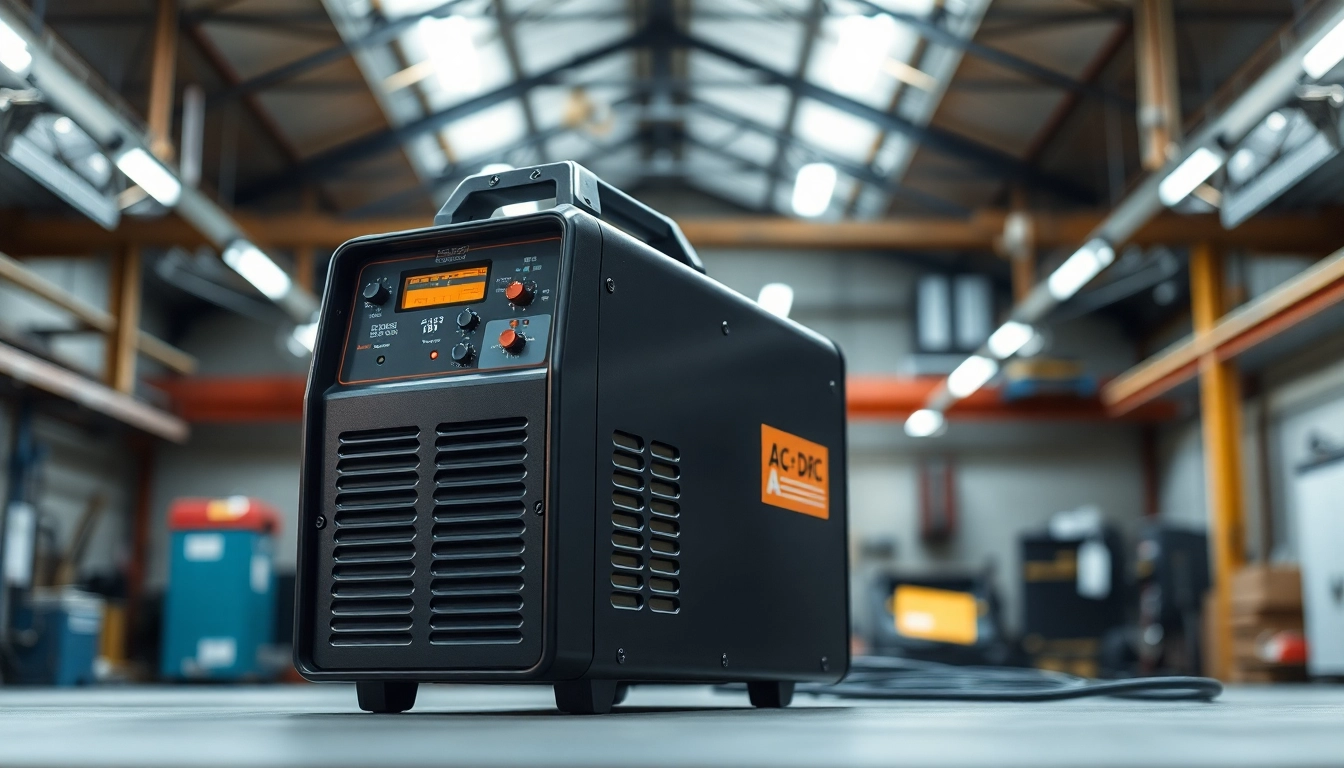Understanding AC DC TIG Welders
TIG welding, or Tungsten Inert Gas welding, is a welding process that relies on a non-consumable tungsten electrode to produce the weld. One of the key advancements in this area is the ac dc tig welder, which can operate on both alternating current (AC) and direct current (DC). This dual capability allows for versatility in welding applications, particularly with various metals. AC is primarily used for welding aluminum and magnesium, as it provides a cleaning effect that removes oxidation. In contrast, DC is ideal for welding steel, stainless steel, and non-ferrous metals. Understanding how an AC DC TIG welder operates provides insight into why it has become a popular choice among welders in various industries.
What is an AC DC TIG Welder?
An AC DC TIG welder is a powerful tool that allows for welding with both AC and DC currents. The AC mode is effective for aluminum welding due to its ability to clean oxides, thus creating a more effective weld. On the other hand, the DC mode is better suited for welding ferrous metals, offering smoother arc stability and greater penetration. This versatility enables welders to handle various materials and thicknesses, making the AC DC TIG welder an essential tool in fabrication shops, automotive repair, and art metalworking.
Benefits of Using AC DC TIG Welders
AC DC TIG welders offer several advantages over traditional welding methods:
- Versatility: Capable of welding a variety of metals including aluminum, stainless steel, and copper.
- Precision: Excellent control over weld pool and greater precision, yielding high-quality welds.
- Less Distortion: Minimal heat input reduces distortion in the base metals.
- Cleaner Welds: AC provides a cleaning action that results in cleaner joints, particularly with aluminum.
- Flexibility: Users can switch between AC and DC, catering to different project demands.
Common Applications for AC DC TIG Welding
AC DC TIG welders are widely used across various sectors. Here are some common applications:
- Fabrication: Industrial fabricators often utilize AC DC TIG welders for producing intricate designs in metalwork.
- Aerospace: TIG welding is essential in the aerospace industry due to its precision and ability to weld thin materials.
- Automotive: Many automotive repairs require the delicacy and precision that TIG welding can provide, especially in exhaust systems and bodywork.
- Artistic Metalworking: Artists use TIG welding to join metal pieces into sculptures and decorative items.
Choosing the Right AC DC TIG Welder
When selecting an AC DC TIG welder, there are several factors and features to consider to ensure you choose the right machine for your needs.
Key Features to Look For
Different models come with a variety of features. Here are some important factors to evaluate:
- Output Current Range: Look for welders with a wide output range (typically from 10A to 250A) to handle various thicknesses.
- Pulsing Capability: This feature allows for better control when welding thinner materials and can improve penetration.
- Type of Cooling: Consider air-cooled versus water-cooled models based on your working environment and usage frequency.
- Foot Pedal Controls: A foot pedal can provide greater control of the welding arc and allow the welder to adjust current while keeping both hands free.
- Portability: If you plan to move your welder frequently, consider its size and weight.
Price Ranges and Quality Options
AC DC TIG welders can range significantly in price based on features, quality, and brand reputation. Here’s a general breakdown:
- Entry-Level Models: Prices for basic models start around $400 to $800. These usually offer fundamental features suitable for hobbyists.
- Mid-Range Models: Typically priced between $800 to $2,000, these welders come with enhanced functionalities like pulse control and wider output ranges.
- Professional Models: High-end welders can range from $2,000 to $5,000 or more. These machines feature advanced technologies, greater power, and are built for heavy-duty applications.
Top Brands in the Market
Given the competitive nature of the welding equipment market, several brands stand out based on quality and performance:
- Miller Electric: Recognized for reliability and performance, Miller offers a range of AC DC TIG welders.
- Lincoln Electric: Known for innovative technology, Lincoln welders are favored in industrial applications.
- Everlast: This brand provides affordable options with a good balance of features for both beginners and professionals.
- PrimeWeld: Offering solid performance at competitive prices, PrimeWeld is gaining traction in the market.
Best Practices for Operating an AC DC TIG Welder
Effective operation of an AC DC TIG welder requires following certain best practices to ensure safety and achieve optimal weld quality.
Safety Tips for TIG Welding
Safety is paramount in welding. Here are critical safety tips to observe:
- Wear Protective Gear: Always wear flame-resistant clothing, gloves, and a welding helmet with proper filter lenses.
- Ventilation: Ensure adequate ventilation to avoid inhaling harmful fumes generated during welding.
- Fire Safety: Keep flammable materials away from the welding area and have a fire extinguisher readily available.
- Check Equipment: Regularly inspect your welder, cables, and accessories for damage before use.
Setup and Maintenance Guidelines
Proper setup and routine maintenance significantly influence the performance of your AC DC TIG welder:
- Setup: Always refer to the manufacturer’s manual for correct setup procedures. Ensure proper grounding and cable connections.
- Maintenance: Regularly clean the torch, change the tungsten electrode when worn, and replace collets and cups as needed.
- Calibration: Periodically check the settings and calibrate the machine to ensure consistent performance.
Tips for Achieving Optimal Weld Quality
To achieve high-quality welds, consider the following recommendations:
- Use the Right Filler Material: Ensure the filler rod matches the base material to prevent chemical reactions and disrupt the weld.
- Adjust the Settings: Master the art of setting amperage based on the thickness and type of material being welded.
- Positioning: Maintain a steady hand and consistent torch angle for optimal arc control and penetration.
Comparing AC DC TIG Welders to Other Welding Methods
Understanding how AC DC TIG welding contrasts with other welding techniques can inform your decision on which method to use for various applications.
AC vs. DC: Understanding the Differences
The choice between AC and DC welding often hinges on the materials being welded:
- AC (Alternating Current): Primarily used for welding aluminum and magnesium. AC can clean the oxide layer from aluminum which can lead to better weld quality.
- DC (Direct Current): More common for steel and stainless steel, offering deeper penetration and a stable arc.
- Versatility: An AC DC TIG welder gives you the flexibility to utilize both currents as needed, enhancing application range.
When to Use AC and When to Use DC
When choosing between AC or DC for your TIG welding projects, adhere to the following guidelines:
- Use AC: For aluminum, magnesium, and other non-ferrous metals.
- Use DC: For ferrous metals such as mild steel and stainless steel.
Pros and Cons of TIG Welding
Like any welding method, TIG welding presents its own set of advantages and challenges:
- Pros:
- High-quality, precise welds.
- Capability of welding thin materials without burn-through.
- Ability to weld a variety of metals effectively.
- Cons:
- Generally slower than MIG welding due to the need for more operator skill and control.
- More complex equipment and setup.
- Suitable primarily for flat and horizontal welding.
Customer Experiences and Reviews
Real-world feedback from users can provide valuable insight into the performance and reliability of different AC DC TIG welders. Here are key takeaways:
Customer Insights on Popular Models
Many users commend models like the PrimeWeld TIG225X for its affordability and high performance, noting especially its effective foot pedal and excellent customer service experience. Such insights can guide prospective buyers towards well-reviewed products that meet their operation requirements.
Expert Reviews of Top AC DC TIG Welders
Expert reviews often highlight key features of leading models. The Miller Syncrowave series is frequently praised for its stout design and efficiency, making it a favorite among professionals. On the other hand, entry-level models from brands like Everlast are often recommended for beginners looking for reliable machines without breaking the bank.
Common Issues and Solutions Shared by Users
Users often share common challenges such as issues with tungsten wear or difficulty with arc stability. Solutions often involve ensuring correct tungsten size, proper electrode angles, and adjusting post-flow settings to enhance performance and longevity.



